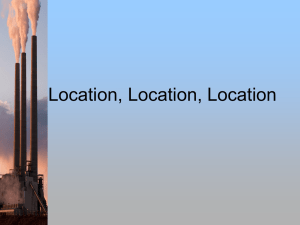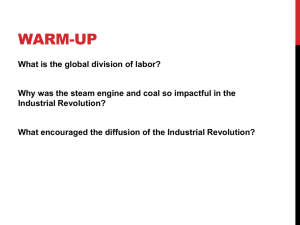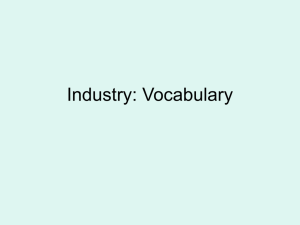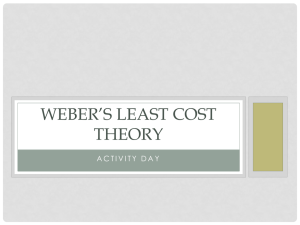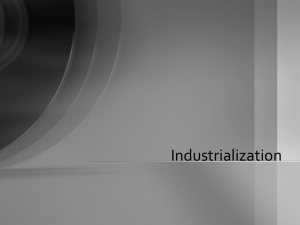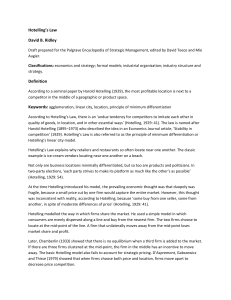Location Theories Snow Version
advertisement
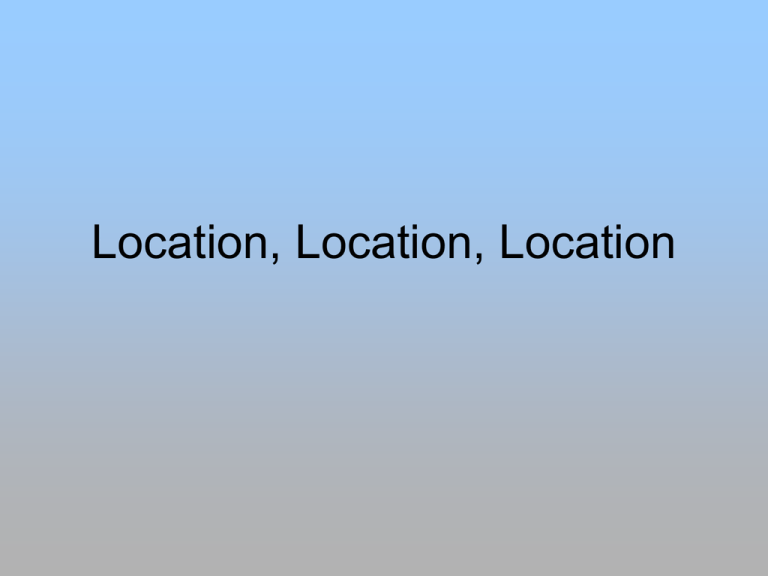
Location, Location, Location Site vs. Situation • Review • Situation factors: involve transporting materials to and from a factory – Minimize cost of transporting inputs to the factory & finished goods to the consumers • Site factors: related to the costs of factors of production inside the plant – Land, labor, capital Situation factors Basic Concepts of Spatial Interaction 1. Complementarity: There must be some form of Supply and Demand Caused by variations in world resources 2. Transferability: Factors = the Cost of moving a particular item and the ability of the item to bear the cost Least Cost Theory • 1909 • Alfred Weber’s model – owners of manufacturing plants seek to minimize costs through: – 1) Transportation, and – 2) labor – 3) agglomeration • Whatever is costing you the most money – reduce the costs! Least Cost Theory – – Weight-losing case: • final product weighs less than raw materials; - it costs money to transport the product, the heavier the costlier. So if the product becomes lighter as it goes through the manufacturing process then put the factory close to the raw materials. That way you are driving the finished (lighter) product a longer distance. The choice becomes should the factory be close to the raw material or the market? • location closer to source Copper industry: • only 0.7% of mined is copper, When you mine copper, most of the stuff that comes out of the ground will be discarded. Only 0.7% is kept, so do you want to pay to transport 1 million pounds of stuff a long way to a factory? Or do you want to go through the stuff close by and drive 0.7% of a million pounds to the market • rest is waste (gangue) • Then concentration process (crush, grind, mix, filter, dry) results are about 25% copper • Then smelting to reduce impurities Least Cost Theory – Aka Bulk-reducing industry examples • steel • Timber mills – Where should the factories be in relation to the source and the customer? Least Cost Theory • Bulk-gaining industry – as the parts come together through the manufacturing process, the product gets heavier or more difficult to move – – – – fabricated metals cars, refrigerators Soft drink bottling (Empty cans or bottles, Syrup concentrate, Water = finished product) • Where should the bottler be located in relation to the can manufacturer and the customer? Perishable Products • An exception – Perishable goods Must locate near market • But not an issue of bulk-reducing or bulkgaining – It is a spoil before getting to the market issue. Labor Intensive Industries • Industries which require a large workforce, so a place with cheap labor • Textiles • Jewelry • Toys • Sawmilling and planing • Footwear Energy Intensive Industries • Industries which take a lot of energy so locate near a cheap energy source – like a large, quick moving river for cheap hydroelectric power • Aluminum • Fertilizer • Cement • Pulp and paper Footloose Industries • Labor, Transportation nor Energy are an issue – so it doesn’t restrict location. May as well locate someplace desirable • Micro-chip • Software design Break-of-Bulk Points • The location where transfer among transportation modes is possible • Costs rise each time cargo has to be loaded and unloaded – Ship – the cheapest – Rail – next cheapest – Truck, or – Air – most expensive (usually only use for perishable products like cut flowers) Site factors Location Models Weber’s Model Manufacturing plants will locate where costs are Hotelling’s Model the least (least cost Location of an industry theory) cannot be understood Theory: without reference to other industries of the Least Cost Theory same kind. Costs: Transportation, Theory: Labor, Agglomeration Locational interdependence Losch’s Model Manufacturing plants choose locations where they can maximize profit. Theory: Zone of Profitability Hotelling’s Model • Harold Hotelling (1895-1973) • Locational Interdependence • Originally locate near customers – but will gravitate to each other to maximize profits • So if you have a cluster of people at A and another cluster of people at C then A and C are both good places to put your ice cream stand. If A then will have all possible business at A. But if you move closer to B then can have all of A and part of C. So C is forced to move closer to B to get part of A market. Losch’s Model: Zone of Profitability • This is just stupid – Businesses should be placed where cost are lowest and profits highest – duh! Changing Markets • Outsourcing – moving a job from being handled within the company to an outside company • New international division of labor – Moving industry to low-cost labor – putting the outsources jobs in a country which is better suited to do the work • Just-in-time Delivery – Factories only keep enough parts for a few hours of assembly. Suppliers constantly bring in more parts. This saves money due to little storage. And makes manufacturing more flexible – if need to change product then don’t have a lot of old parts in storage • Post-Fordist system – more flexible, less mass produced (time-space compression) – see above • deindustrialization Outsourcing BMW Style • High tech corridors – area designated by local or state government to benefit from lower taxes and higher technology infrastructure (Silicon Valley) • Technopole – area planned for high tech where agglomeration built on synergy among tech companies occur (from Dulles Airport – DC has AOL, MCI, Orbital Sciences) • Formal economy – all money earned from work and product sales which are reported to the government • Informal economy – Money earned which is not reported to the government – of course includes illegal drug money – But also all work earned that is not reported for taxes like babysitting, selling vegetables at a farmer’s market, really almost any one that is paid in cash. Sometimes in LDCs, a lot of money is earned in the informal economy.
